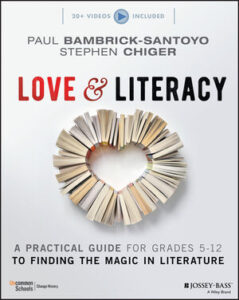Practical Ways to Find the Magic in Literature
Love & Literacy: A Practical Guide to Finding the Magic in Literature (Grades 5-12)
By Paul Bambrick-Santoyo and Stephen Chiger
(Wiley/Jossey-Bass, 2021 – Learn more)
Reviewed by Rebecca Crockett
In the vein of much of my summer professional development reading, Love & Literacy: A Practical Guide to Finding the Magic in Literature promised to help me find ways to get my students more engaged in class by leading them to love reading and by extension analyzing, writing about, and discussing what they had read.
Although as of this writing (August) I haven’t tried out their ideas in a classroom, the authors’ focus on practical delivered. As I delved into this book, I was surprised to find that this was an actual guide and workbook for teachers to make the strategies and moves the authors explain a reality.

The authors believe that “kids fall in love with what they know how to do” and set out to help teachers make sure their students know how to read and understand complex text so that they will feel as passionately about literacy as their teachers do (14).
Designed with limited time in mind
There are four parts to the book, each with multiple chapters with a predictable setup. The authors give helpful information right at the beginning on which chapters will be the most beneficial based on the reader’s current teaching experience and role in education, showing that they know how limited our time and focus can be.
► Part One of Love and Literacy delves into how to design an adequately complex curriculum. For those who think this isn’t achievable in their environments, the authors give ideas for teachable moves to help with the struggle. They note that we need to teach students how to deal with complex text instead of avoiding it.
► Part Two explains how to make student understanding visible. Bambrick-Santoyo and Chiger advocate for the use of annotation and then quick writes (‘stop and jots’) after students complete the reading and before the discussion. They write that “annotation without intention is just decoration” and urge teachers to give time for writing after manageable reading chunks (119).
I love the idea that students have short, clear instruction and a set purpose while they read, leading to a focused writing prompt that helps students think through their ideas and allows teachers time to see what students have discovered on their own and where they need guidance. This section explains in detail what teachers need to do to prepare, the steps they should take, and what the process looks like for students as well.
► Part Three defines discourse versus discussion and lays out how to set students up for success in talking about their reading. Planning ahead, following a cycle and using universal prompts are all part of the keys given in this section.
► Part Four lays out how to implement this in the reader’s own classroom. They advocate for deciding on a couple of key areas, or habits, based on the self-assessments completed throughout the book and then designing a plan to work on one aspect at a time. The book includes detailed instructions for creating a year-long rollout that is workable and not overwhelming.
A potentially transformative read
I appreciated the core ideas that named and explored the strategies described and the key takeaways at the end of each chapter. The ‘stop and jot’ boxes with guiding questions and the one-pagers to help us put strategies to work in the classroom truly made this book.
Self-assessments at the end of each section and the space to make an action plan for implementation in the reader’s classroom helped transform this book from simply useful to truly practical – an instrument in itself for designing a more rigorous curriculum based on annotation, analysis, and discussion.
I found myself seeing reading and student understanding in a new way as I read Love & Literacy, instead of just gathering new tools for implementation. The focus on analysis and how to truly show kids HOW to analyze complex text (and not just telling them to do it and modeling it a bit) provided new insights.
I am looking forward to rolling out my first habits – reading for claim and reading for analysis – when school starts, and I know this is a book I will reference again and again to guide me in doing so.
Lots of credibility here
The authors, Paul Bambrick-Santoyo and Stephen Chiger, have worked with teachers in schools throughout the country and have been part of other well-respected works such as Teach Like a Champion and Driven by Data. Their nods to other notable minds in literacy and education, such as Kylene Beers whose work I know and respect, helped lend credence to their ideas.
The videos, one-pagers (anchor charts), and exemplars make the methods visible, accessible, and transferable. Even better, the companion website offers printable versions of the posters for classroom use and a workbook for easy access.
Love & Literacy: A Practical Guide to Finding the Magic in Literature would be beneficial for curriculum directors, principals, and literacy coaches, but I believe teachers or even teaching teams who are designing and planning their own curriculum would find it the most useful.
Rebecca Crockett currently teaches English in north central Idaho. In her sixteenth year in education, she has taught at both the elementary and secondary levels. She is an avid reader, curriculum planner, and sometimes writer – both for her own enjoyment and to practice what she preaches. Summer finds her devouring professional development books to improve her craft; and she has written many reviews for MiddleWeb.






























